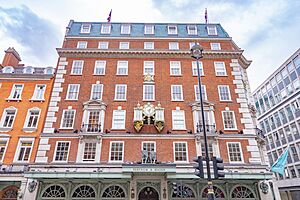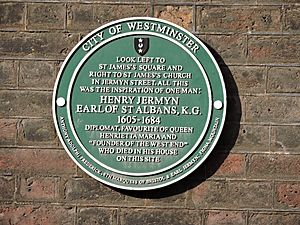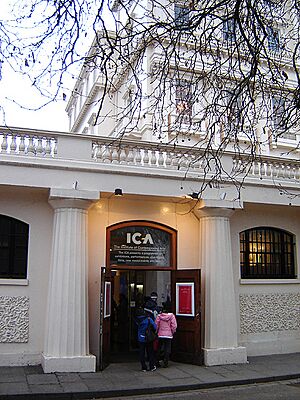St James's facts for kids
Quick facts for kids St James's |
|
|---|---|
 Fortnum & Mason flagship store, Piccadilly |
|
| Population | 10,828 (2011 Census. Ward) |
| OS grid reference | TQ295805 |
| • Charing Cross | 0.5 mi (0.8 km) E |
| London borough | |
| Ceremonial county | Greater London |
| Region | |
| Country | England |
| Sovereign state | United Kingdom |
| Post town | LONDON |
| Postcode district | SW1 |
| Dialling code | 020 |
| Police | Metropolitan |
| Fire | London |
| Ambulance | London |
| EU Parliament | London |
| UK Parliament |
|
| London Assembly | |
St James's is a cool central area in London, found in the City of Westminster. It's part of the famous West End, known for its theaters and shops. This area used to be the gardens and parks of St. James's Palace.
In the 1600s, during a time called the Stuart Restoration, St James's became a popular place for rich and important families (the British aristocracy) to live. Later, in the 1800s, it became famous for its many gentlemen's clubs. For a long time, it was part of the St Martin in the Fields church area. Then, from 1685 to 1922, it had its own church area called St James. After World War II, St James's changed from mostly homes to mostly businesses.
St James's has clear borders. To the north, you'll find Piccadilly and Mayfair. To the west is Green Park. The south side is bordered by The Mall and St. James's Park. To the east, you'll find Haymarket.
Contents
What's in a Name?
The name "St James's" comes from a hospital built here in the 1100s. This hospital was for people with leprosy and was named after Saint James the Less. Today, St James's Palace stands where that hospital once was.
The area also got the nickname "Clubland" because so many gentlemen's clubs were located here. Even a part of Regent Street is now officially called 'Regent Street St James's'.
How St James's Grew
St James's was once part of the same royal park as Green Park and St. James's Park. In the 1660s, King Charles II allowed Henry Jermyn, 1st Earl of St Albans to develop the area. Henry Jermyn turned it into a fancy neighborhood for wealthy families. He planned the streets around St James's Square.
Until World War II, St James's was one of London's most exclusive places to live. Many important buildings are here, including St James's Palace, Clarence House, Marlborough House, and Lancaster House.
Local Government History
St James's used to be part of a larger church area called St Martin in the Fields. This was in the Liberty of Westminster, which was a special area with its own rules. People tried to make St James's its own area several times.
Finally, when St James's Church, Piccadilly was built in 1684, a new church area was created in 1685. This new area was called Westminster St James. It stretched from Oxford Street in the north to Pall Mall in the south.
Famous Streets

St James's has many well-known streets:
- St James's Square: Many of its original houses are still here, but most are now offices. The famous London Library is located here.
- Jermyn Street: This is a fancy shopping street. It's known for custom-made shirts and the best clothes for gentlemen.
- Pall Mall: This street is home to many of London's gentlemen's clubs. You'll also find Marlborough House here, which is where the Commonwealth Secretariat is based.
- Crown Passage: This is a narrow street off Pall Mall. It has the Red Lion, one of the oldest pubs in London's West End that is still open.
- Carlton House Terrace: These are two grand rows of houses designed by John Nash. They overlook St. James's Park.
- St James's Street: This street runs from Piccadilly down to St James's Palace.
Street Names and Their Stories
Many streets in St James's are named after important people or things from the past.
- St Alban's Street is named after Henry Jermyn, 1st Earl of Saint Albans, a politician and landowner from the 1600s.
- Arlington Street** and **Bennet Street are named after Henry Bennet, 1st Earl of Arlington, another important person from the 1600s.
- Bury Street is named after Henry Jermyn, 1st Earl of Saint Albans, who was also Baron Jermyn of St Edmundsbury.
- Carlton Gardens**, **Carlton Street**, and **Carlton House Terrace are named after the old Carlton House.
- Charles II Street** and **King Street are named after King Charles II, who was king when these streets were built.
- Duke Street, St James's** and **Duke of York Street are named after James II, who was the Duke of York when the street was built.
- Haymarket was once a market where hay was sold until the 1830s.
- Jermyn Street is named after Henry Jermyn, 1st Earl of Saint Albans.
- The Mall** and **Pall Mall were built as courses for playing a game called pall-mall, which was popular in the 1600s.
- Piccadilly is named after Piccadilly Hall, the home of a tailor named Robert Baker. He made his money from "piccadills," which were fancy lace trimmings for clothes.
- Regent Street was made in the 1810s by John Nash and named after the Prince Regent, who later became George IV.
- Waterloo Place is named after the Battle of Waterloo, which ended the Napoleonic Wars.
What Happens in St James's Today?
St James's is mostly a business area. It has some of the most expensive rents in London.
- The famous auction house Christie's is on King Street.
- Many fancy art and antique shops are in the surrounding streets.
- BP, a big energy company, has its main office here.
- You can find fine wine shops like Berry Brothers and Rudd on St James's Street.
- Jermyn Street is famous for its tailors and cigar shops, like Davidoff of London.
- Wildsmith Shoes, who designed the first loafer, used to be here.
Culture and Art

St James's has many art galleries.
- The White Cube gallery, which shows art by famous artists like Damien Hirst, has a gallery in Mason's Yard. This was the first new building in the area in over 30 years.
- Other modern art galleries in St James's include Helly Nahmad Gallery.
- On The Mall, which borders St James's, you'll find The Institute of Contemporary Arts and the Mall Galleries.
Gentlemen's Clubs
St James's is known for its many gentlemen's clubs. This is why it's sometimes called "Clubland." These clubs were places where important English people would meet. Different groups, like military officers, politicians, and car lovers, had their own clubs. The Carlton Club, a traditional meeting place for members of the Conservative Party, was damaged in an event in 1990.
See also
 In Spanish: St James's para niños
In Spanish: St James's para niños



